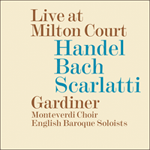
Welcome to Hyperion Records, an independent British classical label devoted to presenting high-quality recordings of music of all styles and from all periods from the twelfth century to the twenty-first.
Hyperion offers both CDs, and downloads in a number of formats. The site is also available in several languages.
Please use the dropdown buttons to set your preferred options, or use the checkbox to accept the defaults.

| The Monteverdi Choir, The English Baroque Soloists, Sir John Eliot Gardiner (conductor)» More |
The break, while brutal, was cathartic: free now to experiment in what he modestly called ‘an ingenious jesting with art’, he set about creating that corpus of more than five hundred dazzling one-movement keyboard sonatas that has held its place in the repertory ever since. Standing well outside the contemporary Baroque concepts of sequential and consecutive expansion, the sonatas were also beyond the reach of parental criticism.
So, too, was his church music—or rather the little of it that has come down to us. Was it in his Neapoli tan childhood that Scarlatti first experienced the scenic pageantry of Holy Week dramas that threatened to burgeon out of strict ecclesiastical control? The Planctus Mariae (Mary’s mourning) formed a popular quasi-theatrical set-piece in Naples’ churches. Might this have lodged in his memory when he sat down to compose his Stabat mater for ten-part choir, soloists and continuo? No amount of musicological sleuthing has so far come up with a firm date, a venue or an occasion for its coming into existence, yet it is by far the most imposing and extended of his works in this genre and one of the most deeply affecting musical settings there has ever been of the Latin hymn by Jacopone da Todi (1230-1306). Finding it hard to imagine the Domenico of the harpsichord sonatas could have produced this astonishing work during his time in Lisbon or at the Spanish court, several scholars plump instead for his Roman years when he worked first for the exiled Polish queen and then as maestro di cappella of the Basilica Giulia. To me, however, although it sits perfectly well with the Counter-Reformation fervour of Baroque Roman art, there is a detectable Iberian flavour to this work—partly to be heard in harmonies that delve back into the siglo de oro and the superb musical artists of that golden age—Morales, Vittoria, Guerrero and Alfonso Lobo—and partly in the dark brooding engagement Scarlatti shows for the grieving of the Madonna, the moment of death (quando corpus morietur …) and the beseeching, inflammatory music he is inspired to write. Just as Handel, crossing the Alps, was invigorated by the new sounds, sights and customs of Italy, so Domenico Scarlatti, responded to the novel cultural milieu of the Iberian courts where he served, allowing exotic new elements to percolate into his musical language. In the course of his Stabat mater Domenico latches on to every opportunity for graphic word-painting, scene-setting (the vertical alignment of ‘Christ above in torment hangs/ she beneath beholds the pangs/ of her dying glorious Son’ in the fourth stanza) and rhetorical outrage (stanzas 5 and 6). His music carries within it the intensity of a Bernini sculpture or the extreme naturalism of a Caravaggio altar tableau, all works of art designed to exhort the listener or viewer to share in Mary’s grief:
Fac me vere tecum flere
crucifixo condolere
donec ego vixero.
(Let me truly weep
to lament the Crucifixion
as long as I shall live.)
At a time when we risk becoming inured to the terrible suffering and loss of innocent lives by the frequency with which graphic images are blazoned across our television screens, the challenge for the singer is not just to empathise with this harrowing emotional outpouring but to address full-on the horror of the most gut-wrenching sort and to project the searing passion of Scarlatti’s ten-part counterpoint with total conviction.
from notes by Sir John Eliot Gardiner © 2014
 Bach, Handel & Scarlatti (D): Live at Milton Court Bach, Handel & Scarlatti (D): Live at Milton Court'Rough edges are minimal, and the performances fizz with John Eliot Gardiner’s dramatic sense. His choir, from which the soloists are taken, remains m ...» More |

